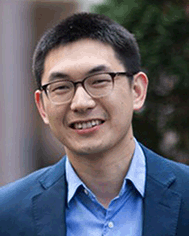Introduction to the honorary themed collection for Thomas P. Russell
Ilja
Gunkel
 a,
Xiaodan
Gu
a,
Xiaodan
Gu
 b,
Jodie
Lutkenhaus
b,
Jodie
Lutkenhaus
 c,
Du Yeol
Ryu
c,
Du Yeol
Ryu
 d,
Jiun-Tai
Chen
d,
Jiun-Tai
Chen
 e and
Zhiqun
Lin
e and
Zhiqun
Lin
 f
f
aAdolphe Merkle Institute, Chemin des Verdiers 4, 1700 Fribourg, Switzerland. E-mail: ilja.gunkel@unifr.ch
bSchool of Polymer Science and Engineering, The University of Southern Mississippi, Hattiesburg 39402, MS, USA. E-mail: xiaodan.gu@usm.edu
cArtie McFerrin Department of Chemical and Biomolecular Engineering, Texas A&M University, College Station 77843, TX, USA. E-mail: jodie.lutkenhaus@mail.che.tamu.edu
dYonsei University, 50 Yonsei-ro, Seodaemun-gu, Seoul 03722, Korea. E-mail: dyryu@yonsei.ac.kr
eNational Yang Ming Chiao Tung University, Department of Applied Chemistry, Hsinchu, Taiwan. E-mail: jtchen@mail.nctu.edu.tw
fDepartment of Chemical and Biomolecular Engineering, National University of Singapore, Singapore 117585, Singapore. E-mail: z.lin@nus.edu.sg
It is with great pleasure that we present this special collection of research papers in honour of Professor Thomas P. Russell, a true pioneer in the fields of polymer science and engineering, self-assembly and solar energy conversion. As we celebrate his 70th birthday, it is fitting to reflect on his many contributions to the field and the impact he has had on the research community.
Throughout his career, Professor Russell has made significant contributions to our understanding of block copolymer thin films, interfacial behaviour of nanoparticles, and X-ray and neutron scattering methods for studying the structure and dynamics of polymer thin films. His research on block copolymers has revolutionised the field of soft matter nanotechnology and his dedication to the development and application of X-ray and neutron scattering methods have enabled unprecedented materials evaluation.
One of Professor Russell's most notable contributions lies in the field of block copolymers. He pioneered the use of block copolymer thin films as templates for the creation of nanostructured materials,1 leading to advances in fields such as electronics, optics and energy storage. His work has led to a better understanding of the self-assembly behaviour of block copolymers2 and the ability to precisely control the structure and orientation of these materials at the nanoscale.1,3,4 As shown in the themed collection, the use of block copolymers as templates for the fabrication of materials with applications including energy storage (https://doi.org/10.1039/D2TA09353G) and for patterning of materials used, for example, in optoelectronics (https://doi.org/10.1039/D2NR06742K) remain active areas of research. The themed collection also features work by Professor Russell himself, who, fittingly, contributes a study assembly of polyelectrolyte star block copolymers at the oil–water interface (https://doi.org/10.1039/D2NR05113C).
Another area of research for Professor Russell is the interfacial behaviour of nanoparticles. He discovered that nanoparticles can segregate at the interface between immiscible fluids and form a liquid-like assembly,5,6 leading to robust encapsulation strategies, porous membranes and double and triple emulsions. He extended these ideas to polymer blends and block copolymers, enabling the spatial organisation of nanoparticles through self-assembly processes. Using functionalised nanoparticles and complementary end-functionalised polymers, he developed a nanoparticle surfactant that self-regulates the number of chains attached to the nanoparticles and increases the interfacial forces holding them in place. This led to the structuring of fluid domains7 with potential applications in all-liquid batteries and ultra-low friction materials. The themed collection includes a recent example of such so-called structured liquids (https://doi.org/10.1039/D2SM01559E).
Professor Russell has also made major contributions to the development and application of X-ray and neutron scattering and reflectivity methods for the study of materials.2,8,9 His work has led to the development of new techniques for characterising soft materials such as block copolymers and organic photovoltaics. In the themed collection, his friend and collaborator Majkrzak highlights Professor Russell's pioneering applications of neutron reflectometry to probe the nanoscale structure of polymer thin film systems (https://doi.org/10.1039/D2NR06756K). Building on Professor Russell's pioneering work, Ganesh, Fuentes-Cabrera, Kumar and co-workers demonstrate the automated analysis of neutron reflectivities of block copolymer thin films using machine learning tools in this themed collection (https://doi.org/10.1039/D2NR07173H). In recent years, Professor Russell has pioneered the use of soft X-rays to quantitatively determine the structure and morphology of complex polymeric systems, including three-phase triblock copolymer morphologies10 and organic photovoltaic active layers.11 He has also made significant contributions to the field of organic photovoltaics itself, where he has developed new methods for controlling the morphology of the active layer in these devices, resulting in higher efficiencies and improved stability.11 Professor Russell's work has helped to lay the scientific foundations for the design of next-generation organic photovoltaics. This themed collection includes several organic photovoltaics studies reporting high efficiencies (https://doi.org/10.1039/D2TA09364B, https://doi.org/10.1039/D2TA09936E, https://doi.org/10.1039/D2TA07113D).
In addition to his impressive research achievements, Professor Russell has made significant contributions to the scientific community through mentorship, education and outreach. He has trained numerous students and postdoctoral researchers who have gone on to become leaders in their fields. He has also held key advisory positions at several major user facilities and national laboratories.
In summary, this collection of research papers serves as a testament to Professor Russell's many contributions to the field of polymer science and engineering. His innovative research and commitment to the advancement of materials science have had a profound impact on the field and will continue to inspire future generations of researchers. We are honoured to celebrate his achievements and ongoing contributions through this special collection.
References
- T. Thurn-Albrecht, J. Schotter, G. A. Kastle, N. Emley, T. Shibauchi, L. Krusin-Elbaum, K. Guarini, C. T. Black, M. T. Tuominen and T. P. Russell, Ultrahigh-density nanowire arrays grown in self-assembled diblock copolymer templates, Science, 2000, 290(5499), 2126–2129 CrossRef CAS PubMed.
- S. H. Anastasiadis, T. P. Russell, S. K. Satija and C. F. Majkrzak, Neutron reflectivity studies of the surface-induced ordering of diblock copolymer films, Phys. Rev. Lett., 1989, 62(16), 1852 CrossRef CAS PubMed.
- P. Mansky, Y. Liu, E. Huang, T. P. Russell and C. Hawker, Controlling polymer-surface interactions with random copolymer brushes, Science, 1997, 275(5305), 1458–1460 CrossRef CAS.
- S. H. Kim, M. J. Misner, T. I. Xu, M. Kimura and T. P. Russell, Highly oriented and ordered arrays from block copolymers via solvent evaporation, Adv. Mater., 2004, 16(3), 226–231 CrossRef CAS.
- Y. Lin, H. Skaff, T. Emrick, A. D. Dinsmore and T. P. Russell, Nanoparticle assembly and transport at liquid-liquid interfaces, Science, 2003, 299(5604), 226–229 CrossRef CAS PubMed.
- X. Liu, N. Kent, A. Ceballos, R. Streubel, Y. Jiang, Y. Chai, P. Y. Kim, J. Forth, F. Hellman, S. Shi and D. Wang, Reconfigurable ferromagnetic liquid droplets, Science, 2019, 365(6450), 264–267 CrossRef CAS PubMed.
- S. Shi, X. Liu, Y. Li, X. Wu, D. Wang, J. Forth and T. P. Russell, Liquid letters, Adv. Mater., 2018, 30(9), 1705800 CrossRef PubMed.
- T. P. Russell, X-ray and neutron reflectivity for the investigation of polymers, Mater. Sci. Rep., 1990, 5(4), 171–271 CrossRef CAS.
- B. J. Factor, T. P. Russell and M. F. Toney, Grazing incidence X-ray scattering studies of thin films of an aromatic polyimide, Macromolecules, 1993, 26(11), 2847–2859 CrossRef CAS.
- C. Wang, D. H. Lee, A. Hexemer, M. I. Kim, W. Zhao, H. Hasegawa, H. Ade and T. P. Russell, Defining the nanostructured morphology of triblock copolymers using resonant soft X-ray scattering, Nano Lett., 2011, 11(9), 3906–3911 CrossRef CAS PubMed.
- D. Chen, A. Nakahara, D. Wei, D. Nordlund and T. P. Russell, P3HT/PCBM bulk heterojunction organic photovoltaics: correlating efficiency and morphology, Nano Lett., 2011, 11(2), 561–567 CrossRef CAS PubMed.
| This journal is © The Royal Society of Chemistry 2023 |






